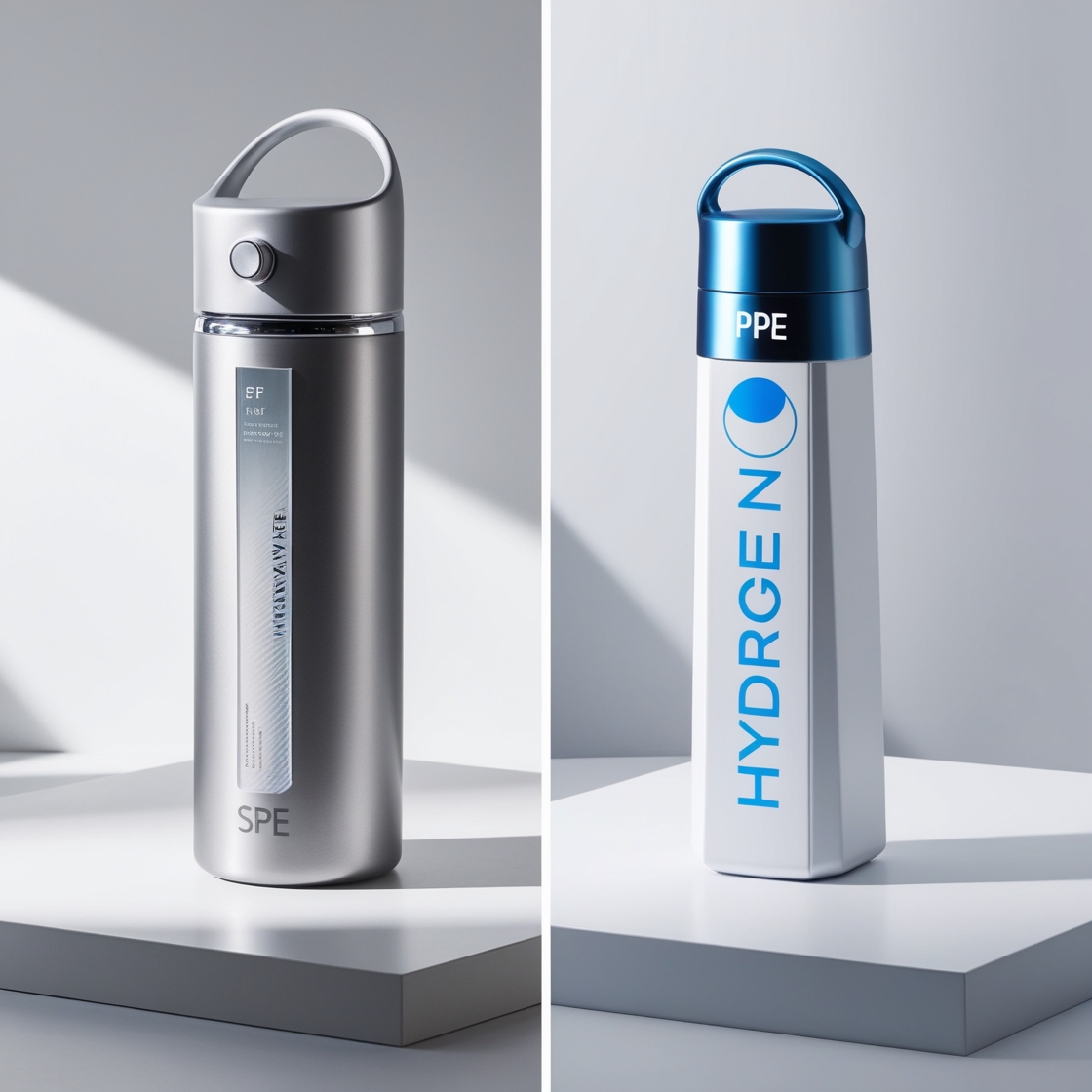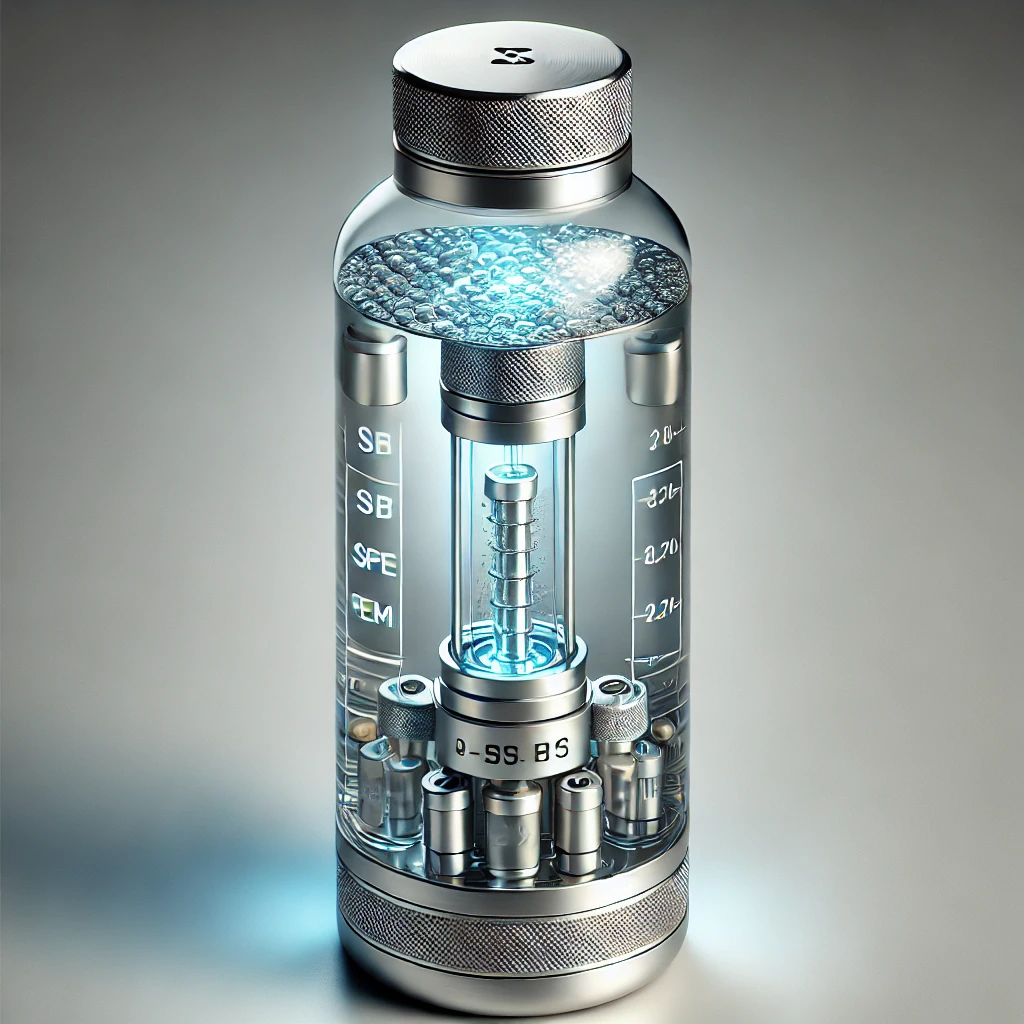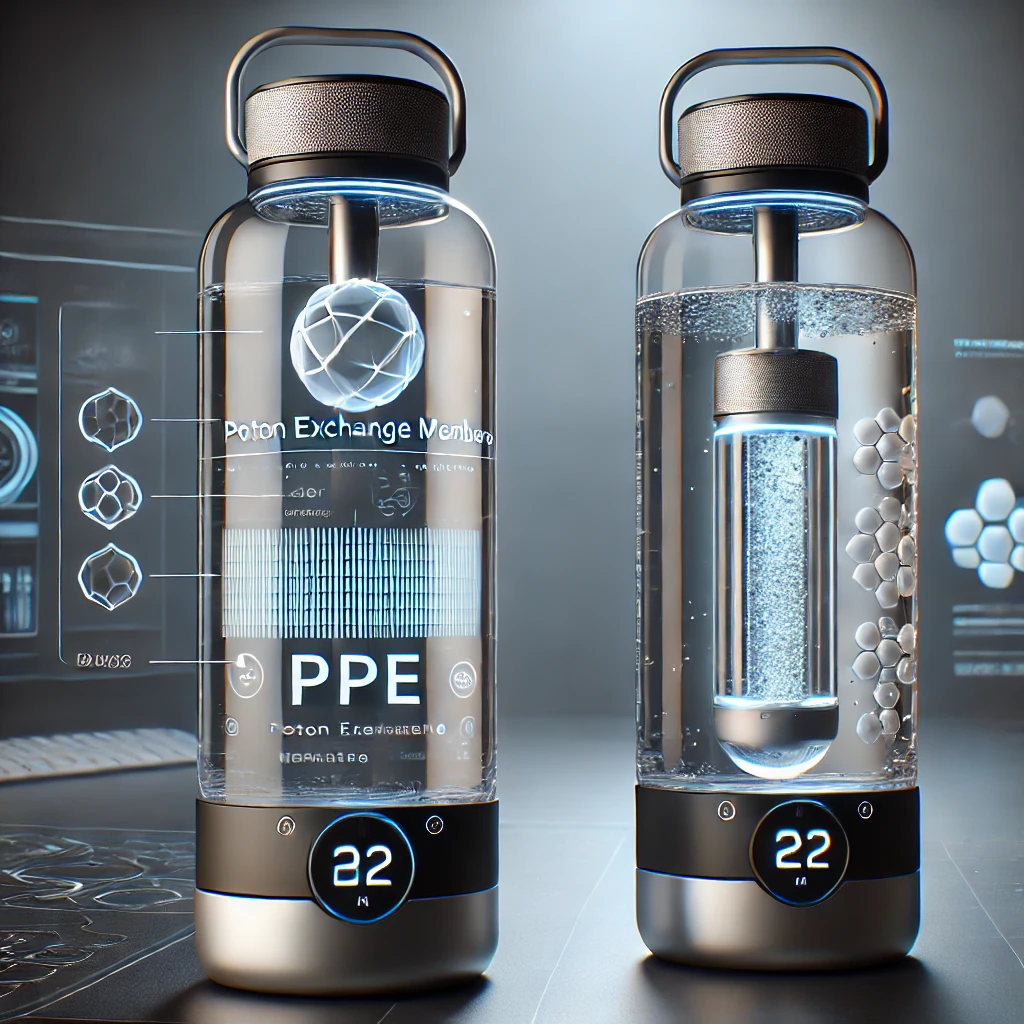SPE vs PPE Hydrogen Water Bottle: What Are The Main Differences?
Hydrogen water bottles infuse regular water with molecular hydrogen, a potent antioxidant with various health benefits. These bottles are growing in demand due to their convenience and the potential advantages of hydrogen-rich water, such as better hydration and enhanced recovery.

This post compares two common technologies used in hydrogen water bottles: Solid Polymer Electrolyte (SPE) and Proton Exchange Membrane (PPE). Both methods involve electrolysis to infuse water with molecular hydrogen, but they differ in their specific mechanisms and the types of membranes used. Understanding these differences will help you choose the right hydrogen water bottle.
For those who do not have much time, this is a very quick and concise comparison table for you:
| Feature | SPE (Solid Polymer Electrolyte) | PPE (Proton Exchange Membrane) |
| Hydrogen Concentration | High hydrogen concentration, superior purity | Moderate hydrogen concentration |
| Cost | Higher initial cost due to advanced technology | More affordable, budget-friendly |
| Durability | Longer lifespan, durable materials | Shorter lifespan, more frequent maintenance |
| Maintenance | Less frequent, lower maintenance requirements | More frequent membrane replacements needed |
| Technology Complexity | Advanced, efficient gas separation | Simpler design, easier to manufacture |
| Best For | Users seeking maximum hydrogen purity and long-term use | Budget-conscious buyers or those new to hydrogen water |
| Brand Availability | Dominant in the premium market | Widely available across various price ranges |
| Typical Price Range | $150 – $300 | $100 – $200 |
Comparison of SPE and PPE Technologies
SPE Technology
Solid Polymer Electrolyte (SPE) technology plays a crucial role in modern hydrogen water bottles. It employs a solid membrane, known as the Solid Polymer Electrolyte, which facilitates the electrolysis process. This membrane is central to separating hydrogen and oxygen gasses during electrolysis, ensuring high hydrogen purity in the water.

The SPE technology operates by passing an electric current through water, which splits the water molecules into hydrogen and oxygen. The SPE membrane acts as a selective barrier, allowing only hydrogen ions (protons) to pass through while blocking oxygen and other impurities. This process results in water with a high concentration of dissolved hydrogen gas, which is the primary benefit sought by users of hydrogen water bottles.
Key Components of SPE Technology
- SPE Membrane: A solid, polymer-based membrane that separates hydrogen from oxygen.
- Electrodes: Usually made of materials like titanium, these are coated to enhance conductivity and durability.
- Power Source: A battery or other electric source that provides the necessary current for electrolysis.
Advantages of SPE Hydrogen Water Bottles
- High Efficiency: The SPE membrane ensures a high rate of hydrogen production with minimal energy loss.
- Superior Hydrogen Purity: SPE technology is known for producing water with a high concentration of pure hydrogen.
- Durability: SPE membranes are robust and have a long lifespan, reducing the need for frequent replacements.
Disadvantages of SPE Hydrogen Water Bottles
- Cost: SPE technology is typically more expensive due to the high-quality materials used.
- Complexity: The advanced technology may require more intricate maintenance.
PPE Technology
Proton Exchange Membrane (PPE) technology is another popular method used in hydrogen water bottles. It uses a membrane similar to SPE but with a different composition and operational mechanism.

PPE technology also relies on electrolysis, but the membrane functions differently. It allows the transfer of protons (hydrogen ions) from the anode to the cathode, while electrons are forced to take an external circuit, creating a flow of electricity that helps in separating hydrogen from oxygen. The result is water infused with hydrogen gas, though often with slightly lower purity compared to SPE.
Key Components of PPE Technology
- PPE Membrane: This membrane facilitates proton exchange while allowing some crossover of gasses, which may reduce purity.
- Electrodes: Similar to SPE, but often less costly due to the materials used.
- Power Source: Provides the necessary electric current for the electrolysis process.
Advantages of PPE Hydrogen Water Bottles
- Cost-Effective: PPE technology is generally more affordable, making it accessible to a broader audience.
- Ease of Manufacture: The simpler design allows for easier production and scaling.
- Widely Used: Due to its lower cost, PPE technology is common in many commercially available hydrogen water bottles.
Disadvantages of PPE Hydrogen Water Bottles
- Lower Hydrogen Purity: PPE membranes are less effective at gas separation, leading to slightly lower hydrogen concentrations in the water.
- Less Durable: The materials used may not last as long, requiring more frequent replacement.
SPE vs PPE Hydrogen Water Bottle Cost
Initial Investment
When considering the cost of hydrogen water bottles, the initial investment is a critical factor. On average, SPE (Solid Polymer Electrolyte) hydrogen water bottles tend to be more expensive than their PPE (Proton Exchange Membrane) counterparts. The primary reason for this price difference lies in the materials and technology used in the manufacturing process.

Comparison of SPE vs. PPE Hydrogen Water Bottles
SPE hydrogen water bottles typically range from $150 to $300, depending on the brand and specific features. In contrast, PPE hydrogen water bottles are more affordable, with prices usually falling between $100 and $200. This difference is significant for consumers who prioritize cost in their purchasing decisions.
Why SPE Bottles Tend to Be More Expensive
SPE technology requires high-quality materials, particularly in the membrane and electrode construction. The SPE membrane is known for its durability and efficiency in producing high-purity hydrogen, which drives up manufacturing costs. Additionally, the engineering involved in ensuring the optimal performance of SPE technology adds to the overall expense. In contrast, PPE technology, while effective, uses less costly materials and a simpler design, making it more affordable.
This cost disparity reflects the value that SPE technology provides in terms of performance and longevity. However, consumers need to weigh these benefits against their budget and specific needs.
Long-Term Value
While the initial cost is important, evaluating the long-term value of hydrogen water bottles provides a clearer picture of overall cost-effectiveness. Both SPE and PPE technologies have distinct advantages and challenges that impact their value over time.
Durability and Maintenance
SPE hydrogen water bottles generally offer superior durability. The robust construction of the SPE membrane and other components means that these bottles often last longer and require less frequent maintenance. This longevity translates into fewer replacements and lower overall costs in the long run. However, regular maintenance, such as cleaning and occasional membrane replacement, is still necessary to ensure optimal performance.
PPE hydrogen water bottles, though less expensive upfront, may not last as long due to the materials used. The PPE membrane may wear out faster, especially with frequent use, leading to more frequent replacements. This can increase the total cost of ownership over time, despite the lower initial investment.
Cost-Effectiveness Over Time
When considering long-term value, SPE hydrogen water bottles are often more cost-effective for those who plan to use the device regularly and for extended periods. The higher initial investment is offset by the reduced need for replacements and lower maintenance costs. Additionally, the superior hydrogen purity and efficiency of SPE technology can provide better health benefits, justifying the higher price.
For those on a tighter budget or with less frequent usage needs, PPE hydrogen water bottles may be a more practical choice. While they may require more maintenance and replacements, the lower upfront cost makes them accessible and a good starting point for users new to hydrogen water technology.
SPE vs PPE Hydrogen Water Bottle Durability
Material Quality
The durability of hydrogen water bottles depends heavily on the quality of materials used in their construction. Both SPE (Solid Polymer Electrolyte) and PPE (Proton Exchange Membrane) technologies rely on specific materials that influence their performance and longevity.

Materials in SPE Hydrogen Water Bottles
SPE bottles typically use high-grade polymers for their membranes, combined with titanium-coated electrodes. The SPE membrane is designed to resist wear and tear, even under frequent use. Titanium coatings on electrodes provide enhanced corrosion resistance, ensuring consistent performance over time. These materials contribute to the bottle’s robustness, making it suitable for users who prioritize long-term durability.
Materials in PPE Hydrogen Water Bottles
PPE bottles, while effective, often use less expensive materials. The membrane in PPE technology is generally a more standard polymer, which may not withstand prolonged or intensive use as well as SPE membranes. Electrodes in PPE bottles might also be made of less durable materials, reducing the bottle’s resistance to wear and tear.
Comparison of Resistance to Wear and Tear
In high-usage scenarios, SPE hydrogen water bottles demonstrate superior resistance to wear and tear. The high-quality materials used in SPE bottles make them more durable, especially when used frequently. PPE bottles, though less costly, may show signs of degradation faster when subjected to the same usage levels. This difference is critical for users who plan to use their hydrogen water bottles daily or in demanding environments.
Lifespan and Maintenance
The lifespan and maintenance requirements of SPE and PPE hydrogen water bottles further differentiate these technologies.
Expected Lifespan of SPE vs. PPE Hydrogen Water Bottles
SPE hydrogen water bottles typically have a longer lifespan due to their superior materials. With proper care, an SPE bottle can last several years, making it a worthwhile investment for long-term users. The robust construction of the SPE membrane and electrodes ensures that the bottle maintains its performance throughout its lifespan.
PPE hydrogen water bottles, while more affordable, generally have a shorter lifespan. The standard polymer materials used in PPE membranes may degrade faster, especially with frequent use. As a result, PPE bottles might require replacement sooner, which could increase the overall cost of ownership over time.
Maintenance Requirements
For SPE bottles, maintenance involves regular cleaning of the electrodes and periodic replacement of the membrane. Due to the durable materials, SPE bottles may require less frequent membrane replacement compared to PPE bottles. Following the manufacturer’s care tips, such as using distilled water and avoiding prolonged exposure to high temperatures, can further extend the lifespan of an SPE bottle.
PPE bottles, on the other hand, may need more frequent membrane replacements due to the quicker degradation of materials. Cleaning is still essential, particularly for the electrodes, to prevent buildup that could affect performance. Users should be mindful of the maintenance schedule provided by the manufacturer to avoid premature wear.
Choosing the Right Technology: SPE vs PPE Hydrogen Water Bottle
The best choice between SPE and PPE hydrogen water bottles depends on your specific needs and preferences. Consider the following factors:
SPE vs PPE Hydrogen Concentration
Impact of SPE Technology on Hydrogen Concentration
SPE hydrogen water bottles are known for producing higher hydrogen concentrations. The solid polymer electrolyte membrane used in SPE technology efficiently separates hydrogen from oxygen, ensuring that the water is rich in dissolved hydrogen. This high concentration is ideal for users who seek maximum hydrogen levels in their drinking water.
Impact of PPE Technology on Hydrogen Concentration
PPE hydrogen water bottles, while effective, often produce slightly lower hydrogen concentrations compared to SPE bottles. The proton exchange membrane in PPE technology, although functional, may allow some gasses to mix, resulting in less pure hydrogen water. This makes PPE bottles a suitable choice for users who are content with moderate hydrogen levels and prefer a more budget-friendly option.
Which Technology is Better for Higher Hydrogen Levels?
For users focused on achieving the highest possible hydrogen concentration, SPE technology is the preferred choice. Its advanced membrane ensures superior gas separation, leading to higher hydrogen purity. PPE technology, though adequate, is better suited for those who prioritize affordability over maximum hydrogen levels.
SPE vs PPE Budget
Budget Considerations for SPE Technology
SPE hydrogen water bottles are generally more expensive due to the high-quality materials and advanced technology involved. For those willing to invest in premium options, SPE technology offers long-term benefits, such as greater durability and higher hydrogen purity. However, the upfront cost may be a barrier for budget-conscious buyers.
Budget Considerations for PPE Technology
PPE hydrogen water bottles are more accessible in terms of price. The simpler design and less expensive materials make PPE technology a cost-effective option. For users on a tight budget or those new to hydrogen water, PPE bottles provide a practical starting point without sacrificing too much in terms of functionality.
Advice for Budget-Conscious Buyers
If budget is a primary concern, PPE hydrogen water bottles are a smart choice. They offer the essential benefits of hydrogen water without the higher price tag associated with SPE technology. For those who can afford to spend more, SPE bottles provide a superior experience with enhanced durability and hydrogen concentration.
SPE vs PPE Durability
The durability of SPE Hydrogen Water Bottles
SPE bottles are built to last. The materials used in SPE technology, such as the solid polymer electrolyte membrane and titanium-coated electrodes, are designed for long-term use. These components resist wear and tear, making SPE bottles the best choice for those seeking a durable, low-maintenance option.
Durability of PPE Hydrogen Water Bottles
PPE bottles, while durable, do not match the longevity of SPE bottles. The materials used in PPE technology are less robust, which can lead to a shorter lifespan, especially with frequent use. However, for users who do not need the highest durability, PPE bottles offer a reasonable compromise between cost and longevity.
Best Options for Long-Term Durability
For users who prioritize long-term durability, SPE hydrogen water bottles are the superior choice. Their construction is designed to withstand years of use, making them a better investment for those looking for a product that will last. PPE bottles, while less durable, are still a viable option for those with less demanding durability requirements.
SPE vs PPE Brand Reputation
Importance of Choosing Reputable Brands
Reputable brands are more likely to offer high-quality products, backed by warranties and reliable customer service. They also tend to use better materials and employ stricter quality control measures, which are vital when investing in technology like SPE or PPE hydrogen water bottles.
Popular Brands Offering SPE and PPE Hydrogen Water Bottles
- SPE Technology: Brands like Lourdes Hydrofix, H2Wellness, and Trusii are well-known for their high-quality SPE hydrogen water bottles. These companies are recognized for their commitment to using superior materials and delivering products with consistent performance.
- PPE Technology: Brands like LevelUpWay, H2WaterForLife, and GOSOIT offer reliable PPE hydrogen water bottles at more affordable prices. These brands have built a reputation for providing good value for money, making them popular among budget-conscious consumers.
Overview of Market Reputation
SPE brands tend to dominate the premium segment, offering products that emphasize durability and high hydrogen concentration. PPE brands, on the other hand, are more prevalent in the mid-range market, appealing to consumers who seek a balance between cost and functionality. Choosing a brand with a strong market reputation ensures that you are investing in a product that will meet your expectations.
Conclusion
SPE and PPE hydrogen water bottles differ in hydrogen concentration, cost, and durability. SPE bottles offer higher hydrogen purity and long-term durability, while PPE bottles are more budget-friendly. When choosing, consider your budget, desired hydrogen levels, and usage needs. Investing in a quality hydrogen water bottle ensures you get the best results.
Visit our website to discover the best hydrogen water bottles tailored to your needs. Make the right choice for your health today!
FAQs
- What Is the Main Difference Between SPE and PPE Technology?
SPE uses a solid polymer electrolyte for higher hydrogen purity, while PPE employs a proton exchange membrane, offering a more budget-friendly option with slightly lower purity.
- Which Technology Provides Better Hydrogen Concentration?
SPE technology provides better hydrogen concentration due to its more efficient gas separation process.
- Are SPE Hydrogen Water Bottles Worth the Higher Cost?
Yes, if you prioritize long-term durability and higher hydrogen purity, SPE bottles are worth the investment.
- How Often Should I Replace the Membrane in My Hydrogen Water Bottle?
For SPE bottles, the membrane typically lasts longer and may need replacement every 1-2 years. PPE membranes might require replacement more frequently, depending on usage.
- Can I switch between using SPE and PPE hydrogen water bottles?
Yes, you can switch between them, but keep in mind the differences in hydrogen concentration and maintenance requirements.
